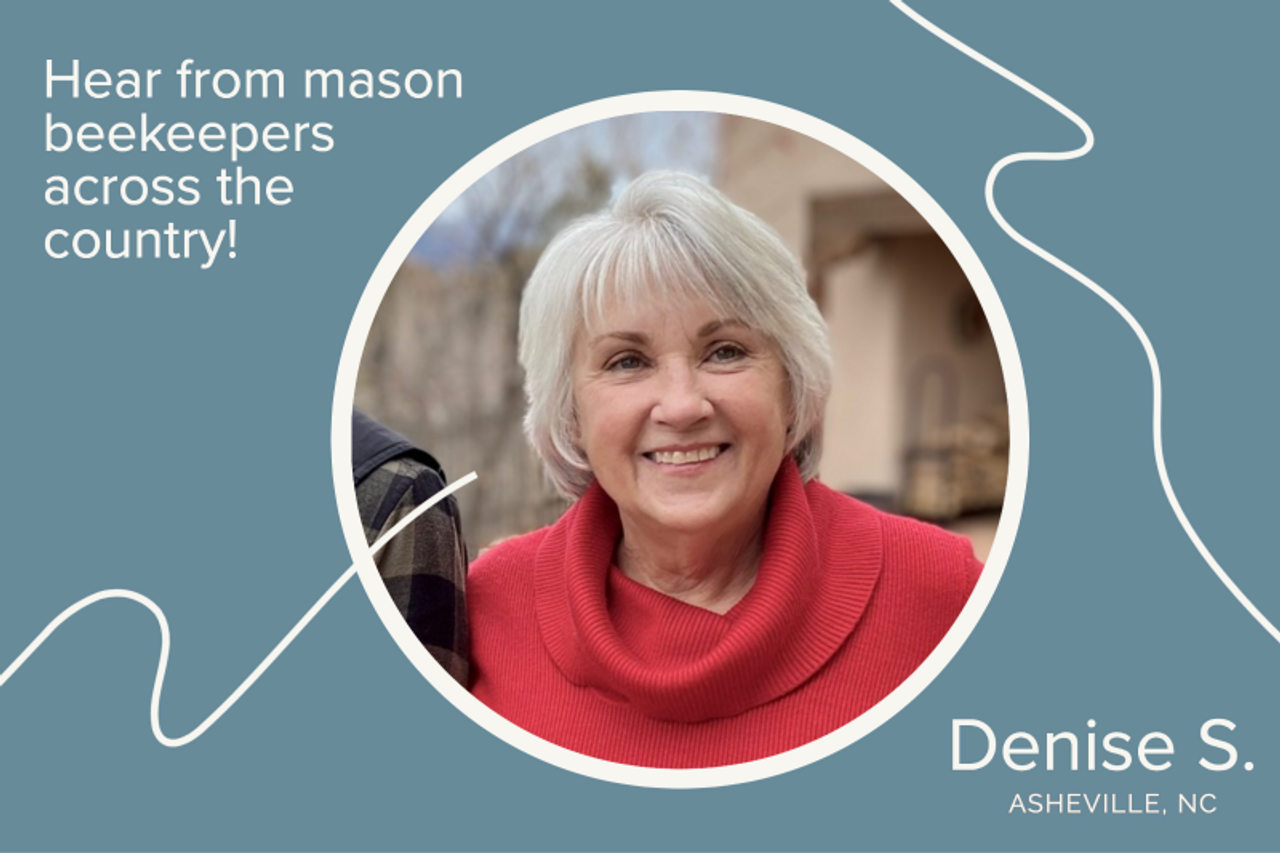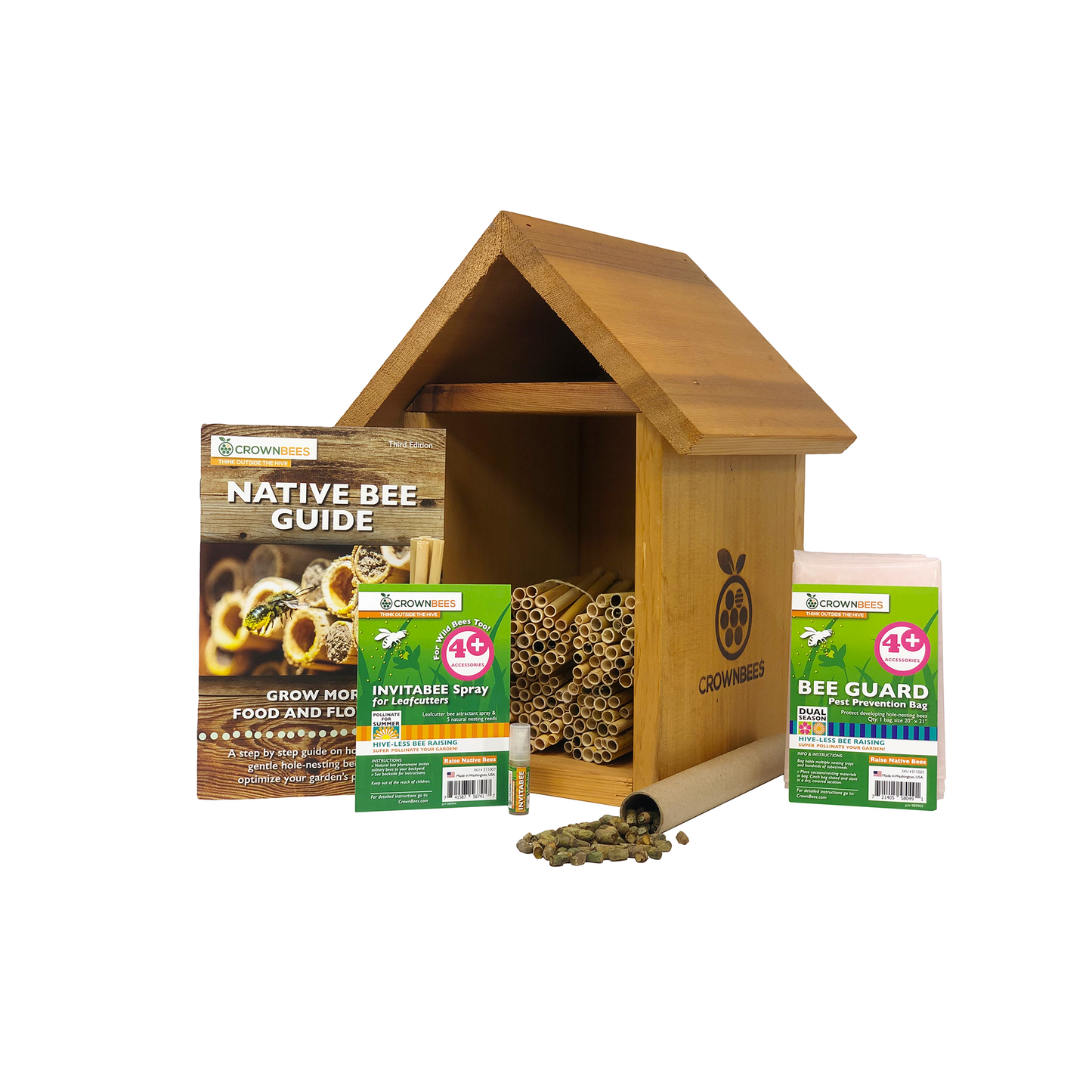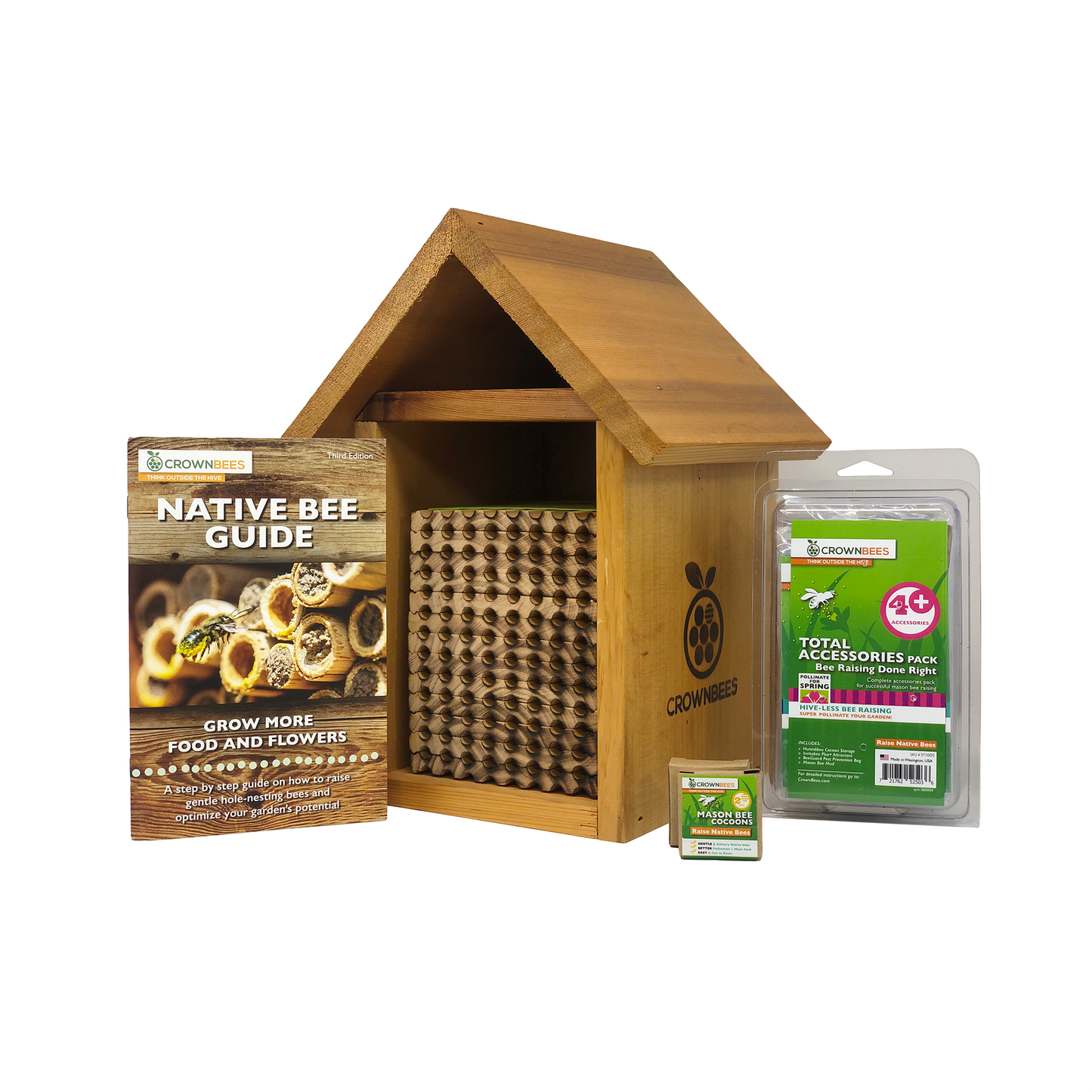
Don't just take our word for it! We're excited to share this blog on learning from the experiences of others in mason bee raising. Everyone's journey with mason bees is unique. Whether you're just starting or an experienced beekeeper, there's always something new to learn. That's why we're bringing you voices and perspectives from across the country to give you insight into what it's like to raise these gentle pollinators. We've got a bit of everything from challenges and triumphs to tips and tricks!
Thank you so much to Denise, Darcy, and Jim for sitting down and chatting with us about their experiences with mason bees over the years! We learned a lot and are inspired by your passion for sharing knowledge about these fantastic pollinators with your local communities and us!
We asked each of these experienced mason bee raisers the same questions to learn the similarities and differences in their beekeeping journey. So without further delay, let's dive into our interviews and know more about Denise's, Darcy's, and Jim's journey as mason bee raisers.
Tell us a little about yourself. What part of the country do you live? How long have you been raising mason bees?
Denise — I currently live in Asheville, North Carolina. I grew up in Virginia, and most of my experience with bees was there. I just moved back from Santa Fe, New Mexico. I was there for about nine years. I loved it, but because of the Rocky Mountains, none of my favorite bees could get over the mountains. So it's nice to be back in North Carolina and on the East Coast.
It's been about 15 years since I first became interested in mason bees. I was going to ask Dave because he and I started at about the same time!
Darcy — My name is Darcy, and I'm a mom in the Seattle area, and I've been raising mason bees for 15 years.
Jim — Okay, I'm in my seventies and have been married for 48 years to my college sweetheart. I've been a resident of West Lafayette, Indiana for about seven years since I retired, and I've been raising mason bees for about six years now.
What made you want to get started raising mason bees?
Denise — I kept hearing about the decline of honeybees, so I decided to take a honey beekeeping class. I learned something that just really shocked and surprised me in that class. There are no honey-producing bees that are native to North America. Wow! And so I thought if honey bees have only been on this continent for less than 400 years, what in the world was successfully pollinating all of our plants for the millions of years before that? So that is really what prompted my research, interest, and passion, as it turned out, for native bees.
Darcy — I saw them at a garden show. Initially, I was walking around buying plants and flowers, and there was a little booth for Mason bees, and I thought that sounded fun. It's like a little backyard science experiment. So I got the kit and waited to see what would happen.
Jim — So I was initially going to raise honeybees until my wife pointed out that I am very allergic to bee and wasp stings. And she said, "Hey if you're determined to do that, give me some time to get more insurance." So I thought, maybe I need to find bees that don't sting.
I don't remember how exactly I stumbled across mason bees. I guess I was Googling "bees that don't sting," and I stumbled on the website and figured, hey, this might be a good alternative, and it has been a really good alternative.
These bees just don't sting. I mean, I'm sure they could. But they don't. I've put my face up right next to the house while they're flying around to check and see what's going on. And they'll just wait for me. They'll have a load of pollen or mud and wait for me to get out of the way. Oh, they're very calm.
What would you say is your favorite part about raising mason bees?
Denise — Watching them! Knowing what stage they are in throughout the year and building their brood chambers is interesting to me, but I also enjoy the fruits of their labor. You know, in the fall, I love opening the nesting tubes. It's very gratifying, you know, to see all these beautiful, healthy pollinators that are developing and knowing you're adding something good to the environment and, of course, on a more personal level, it's nice because you know that they're helping pollinate and adding flowers and veggies to my yard. And also, it's really fun and very easy!
Darcy — Waiting to see when they hatch. That's an exciting time every spring, and I check the bee house everyday to see what's going on. And I get very excited when they first start to emerge.
Also, my kids like to look at them and count them when I put them out in the spring. They like to report on what kind of activity they see when they come home from school. So they inspect the house everyday and give me the bee report.
Jim — Well, two parts, really. First, when you're putting the bees into the house in the spring, you're emptying them from your HumidiBee into the little release tube. And as you're doing that, some of them, if they're low on fat reserves, are ready to pop out. As you're holding the cocoons in your hand, the bees will pop out when the sun hits them pretty quickly.
I put the cocoons in the tube and let the bees that just popped out crawl around on my hand or arm or whatever, and they don't hurt you or anything. They're just waking up and warming up. And once they feel ready, they fly off and go look for something to eat. So that's fun.
But my favorite part is when we're opening the reeds, which is also the most work even though there's only a little work involved in these guys. I've given bees to a lot of families within a mile of my house, and we pick a Saturday, and we have a reed opening party at my home. And that's fun because we have cider, donuts, and coffee for the adults. And we sit there and crack open the reeds and see who's got what and, you know, sometimes there's a surprise.

Above Image: Darcy's daughter helping to release mason bee cocoons in the spring.
What would you say is one of the biggest challenges in raising mason bees?
Denise — There weren't really any challenges. When I started, everything was so new, so the only challenge for me was that I was an architect by trade, and I tried to design the best house for this little bee client. So there was a lot of trial and error.
But you know, the biggest challenge now is avoiding incorrect information on the internet. Yes, you can get your products and information from a dedicated website like Crown Bees, which has probably been around longer than most other sites. And that's really, to me, the only challenge. Otherwise, you shouldn't have any problems. The information is out there, especially on that [Crown Bees] site. And then enjoy [the bees] and know that you're doing something worthwhile for our food supply.
Darcy — It's the weather. We've had some unusual weather in the Pacific Northwest these last couple of years. The challenge is trying to do my best every year to put them out at the right time, and time it so that they [the bees] have lots of flowers. So what I do is staggered releases, and I release them over a four-week period. Every week I check how many bees have emerged and how many haven't, and I keep putting them out so I improve their chances of survival.
Jim — Critters, like ants, wasps, and raccoons. Everybody will have different challenges depending on what part of the country you're in or where you're at. But I found that raccoons will climb up if you put the bee house in a tree or on a tree. They don't destroy the reeds but love pulling them out of the house and throwing them on the ground. One guy put a heavy-duty cover on the house made of quarter-inch wire, and the raccoons took the whole house!
Some tricks I found to get around that are mounting the boxes on a house or garage wall. And, of course, you want to face them south or southeast.
There's plenty of material on the Crown Bees' website, lots of videos that tell you that stuff.
Yeah, so that's one challenge is the critters, but I've developed strategies to combat it nicely with readily available materials.
Watch the full interview with Jim to learn more about his strategies!
What would you tell someone that is considering raising mason bees?
Denise — Well, I would make sure that they realize that these bees are not aggressive. I've never ever been stung by one. And so people who are allergic, like my child, don't have to be scared of these bees.
Also, if it is a time concern, raising mason bees only takes a couple of hours in the spring to set up the houses and a couple more hours cleaning out the nest holes in the fall. And it's also a wonderful way to introduce children to the wonder of bees and pollinators in general so that they don't grow up with the fear of being stung.
Darcy — It's super easy. It's easier than you think. And it's fun to watch. It's very rewarding. My daughter is always trying to get them to land on her finger. And she's very excited when they do!
Jim — Well, it's not nearly as much work as honey bees. I've never raised honey bees, but I have friends that do, and it's not nearly as much work. Of course, you don't get honey from mason bees. But you only have a couple of periods of the year where you're working even a little bit. In the spring, it takes a half hour to set up the houses, put the reeds in, put the bees in, cover them up with the mesh, and then you're done. And then you can enjoy watching them flying in and out and see the new reeds fill up each day as you walk the dog past the house or are outside gardening. And then, around July, when the bees quit flying. It only takes about 15 minutes to take the house down, check all the reeds to see which ones are full or partially full and store them until harvest time. I store mine in mason jars.
Watch the full interview with Jim to learn more about his mason jar storing techniques.
If there was one word you could use to describe your experience with mason bees, what would it be and why?
Denise — I would say the number one word that comes to mind is fascinating. Just to know what an insect can accomplish on so many levels. It's just fascinating to me. But I would also say enriching because I have learned so much about pollinators. And I have really enjoyed sharing that knowledge with other people like master gardeners and school kids — it's really very fun. And I never get tired of the astonished reaction when I share that there are about 4,000 different species of bees in just North America alone. And it's funny because it really just blows their minds - their eyes get big like a little emoji. So you know, I'd say it really has been enriching for me to share these bees with others.
Darcy — I mean, I would say anticipation or observation. I like looking back on the year and going, Ah, that's how that went. So I like it. I'm very analytical and like evaluating and seeing how it went every year, and I write down how it went every year on a bee excel sheet so I can look back at history.
Jim — It's pretty calming. Just handling them [the bees], and harvesting them, and working with other people, especially the little kids. Yes, it's just a very calming activity. You know, [during harvesting] we'll sit there and harvest cocoons, and you know, its sort of God's little creations that he's put in there, and, I just find it a calming activity.

Above Image: Darcy counts bee butts at night with a flashlight to see how many are actively nesting.
How has Crown Bees helped you on your bee raising journey?
Denise — I know you know, but the Crown Bees' website is awesome. And the thing that I have always appreciated about Crown Bees' is that all their products are so apropos and so well-researched. You know, the depth of a hole and the size of a nesting tube are incredibly important. And so I love that the goal of Crown Bees is not just to sell products. You can read their website, and often it's not about just making money. It is full of very well-researched, expert advice that is only meant to help people raise healthy bees and to enjoy the experience along the way. And that's a rarity these days. And that's something that I have always appreciated about Dave and the [Crown Bees] website.
Darcy — Crown bees cares about the quality of the material, and they want to make sure that the bees are successful, so they sell products that they know support success, and I trust them for that. There are a lot of people out there who'll just sell anything bees would nest in, and it's not good for the life of the bees. So I like how they're very invested in success for the bees and the gardener.
Jim — When I started six years ago, the Crown Bees' website was pretty good with information, and it has gotten nothing but better with all the instructional videos, handouts, and things. And I can copy as much as I want to hand out to the people I work with, and I appreciate it. It's nice to be part of a network like that.
Is there anything else you'd like to share about your experience working with mason bees?
Denise — It'd be wonderful if you could hang a bee house. But even if you can't [hang a bee house], it would help a lot if you planted some early-blooming native plants. Even if it's just a few plants in a planter on your deck, just plant whatever is native in your area because mason bees emerge in early spring, and if there isn't much for them to forage on, they won't do well. So people need to think about that, you know, the leafcutter bees have a lot to choose from in the summer, but this is different for mason bees. Just leave the dandelions in your yard because they are a great source of nectar and are about the earliest blooming flowers for the native bees.
Darcy — [Raising mason bees] is always a surprise! Every year I love opening up and harvesting and seeing how things went with the bees. It brings excitement to my fall when my garden starts to slow down — we still have something fun and outdoors to do with bees.
I also hang my bee houses on the front of my home because that's the best sunshine, and the neighbors are always very interested in what's happening. When my neighbors observe me looking at the bees every week, they get interested too. And I've been able to give my extra bees away to about 30 people over the years and get them interested. I even had a Girl Scout do a big project on mason bees and exhibit it at the library.
Jim — I'm sure it would encourage people to know that if you do get started, you end up with more bees than you started. And it's nice to share with people because it's not terribly time-consuming. Oh, speaking of which, I bought this reed splitter from the Crown Bees website this year, and this thing makes it [harvesting] go so much quicker.
But I would say even the old split-it-with-your-fingers method is not that hard. It's just a little more time-consuming and cleaning all the frass off so you can store them takes time, but it's a community event. And if you've got friends and relatives around you, or even if you don't and you want to make some friends, you can usually find somebody that likes to garden or something and share it with them and make new friends.


